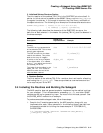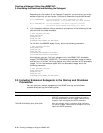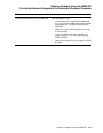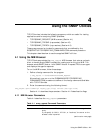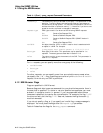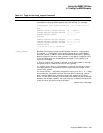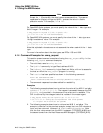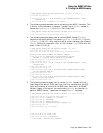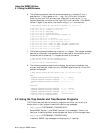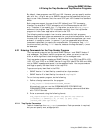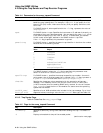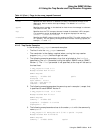
Using the SNMP Utilities
4.1 Using the MIB Browser
Table 4–2 (Cont.) Flags for the snmp_request Command
Flag Description
-l
Specifies loop mode. Note that this flag is the letter l, not the number 1.
Valid only if
request-type
is
GetNext
or
GetBulk
(where flag
n
is set to
0, and flag
m
is set to a number greater than 0).
Causes the master agent to traverse all the MIBs registered with the master
agent, starting at the first OID after the one specified in the command.
(Note that you can specify only one
variable-name
[OID].) Responses are
received one at a time, and for each one, the OID returned by the master
agent is used in a subsequent request. Corresponds to the behavior of
standard
mibwalk
programs.
The MIB browser reads and displays responses, and issues requests until
the master agent has no more data, times out, or you press Ctrl/Y or Ctrl/C.
If specified with the
GetBulk
request, the
-n
and
-m
flags and associated
values are ignored, and the behavior is identical to that of
GetNext
.
When the last OID handled by the master agent is reached, you receive a
response similar to the following for a query on OID 1.3.6.1.6.3.1.1.6.1 using
SNMP Version 1:
1.3.6.1.6.3.1.1.6.1.0 = 693056825
- no such name - returned for variable 1
For a query using SNMP Version 2, the example response is:
1.3.6.1.6.3.1.1.6.1.0 = 693056825
1.3.6.1.6.3.1.1.6.1.0 = - end of mib view -
These examples assume that:
• OID 1.3.6.1.6.3.1.1.6.1.0 is the last OID supported on the target host.
• The target host is running an SNMP Version 2 agent.
The statement
end of mib view
refers to OIDs for all MIBs registered with
the master agent.
-m max_repetitions
Specifies the number of repetitions requested for repeating variables.
Applies only to the
GetBulk
and
GetNext
requests.
Note that the resulting display can be confusing because the results for the
repeater OIDs are interleaved. That is, the OIDs are displayed in alternate
progression for faster memory throughput. If you specify
GetBulk
without
specifying both the
-m
and
-n
flags, the results are unpredictable.
-n non_repeaters
Specifies the number of variables for which no repetition is requested.
Applies only to the
GetBulk
request. If you specify
GetBulk
without
specifying both the
-m
and
-n
flags, the results are unpredictable.
-p port
Specifies the port where the request is to be sent. If not specified, the
request is sent to well-known SNMP port 161.
-r max_retries
Specifies the number of times the MIB browser resends a request packet
if it times out before receiving a reply. Specify a positive integer for the
value (max_retries). If you specify a negative value, it will be converted to an
unsigned positive integer. If you specify 0, no retries are tried.
If, after a timeout and a resend, a reply packet is received, the resend
counter is reset. After another timeout, the specified number of max_retries
is sent.
(continued on next page)
4–4 Using the SNMP Utilities




